 |
 |
 |
| |
Impact of COVID-19 and Host Factors
on the Humoral Immune Repertoire in Treated HIV
|
| |
| |
CROI 2023 Feb 20-23
Samuel R. Schnittman,1 Wonyeong Jung,2 Kathleen V. Fitch,1 Markella V. Zanni,1 Sara McCallum,1 Jessica Lee,2 Sally Shin,2 Brandon J. Davis,2 Evelynne S. Fulda,1 Marissa Diggs,1 Judith Currier,3 Pamela S. Douglas,4 Heather J. Ribaudo,5 Galit Alter,2 and Steven K. Grinspoon,1 for REPRIEVE Investigators
1Massachusetts General Hospital, Boston, MA, USA, 2Ragon Institute of MGH, MIT, and Harvard, Cambridge, MA, USA, 3University of California at Los Angeles, Los Angeles, CA, USA, 4Duke University, Durham, NC, USA, 5Harvard T.H. Chan School of Public Health, Boston, MA, USA
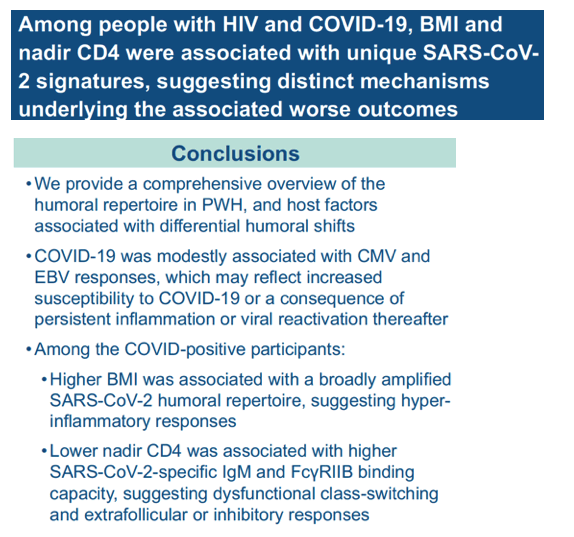
program abstract
Background: People with HIV (PWH) on antiretroviral therapy (ART)
appear to be at higher risk for worse COVID-19 outcomes, but the underlying mechanisms-including effects of COVID-19 and host factors on the broader humoral immune repertoire-are poorly understood.
Methods: REPRIEVE enrolled a global cohort of ART-treated PWH ages 40-75. COVID+ was defined by positive receptor binding domain IgG or IgA from annual visits 5/2020-2/2021. Antibody isotype, subclass, and Fc receptor Luminex arrays to SARS-CoV-2, CMV, EBV, HSV, HIV, influenza, pneumococcus, and RSV were assessed. Report of COVID diagnosis (collected every 4 months) was defined as mild, moderate, or severe (asymptomatic if no clinical diagnosis but IgG/IgA+). FDR-corrected regression was used to assess effects of 1) COVID+ on non-SARS-CoV-2 repertoire in full cohort and 2) host factors on non-SARS-CoV-2 and SARS-CoV-2 repertoire in COVID- and COVID+ cohorts, respectively, adjusted for age, sex, region, nadir CD4, and HIV VL at entry.
Results: Of 2,464 unvaccinated participants, 283 (11%) were COVID+; 260
(92%) were asymptomatic. Median age was 53, 35% were women, 50% had nadir CD4 < 200, median current CD4 was 649, and 97% had HIV VL < 400.
In the full cohort, COVID+ was associated with higher CMV PP65 IgG3 and FcγRIIA (P< 0.05); COVID severity was not associated with the non-SARS-CoV-2 repertoire. Among COVID-, older age, female sex, and lower nadir CD4 were associated with higher EBV and CMV responses; IgG1 levels were higher in women for all non-SARS-CoV-2 antigens assessed (P< 0.05). Among COVID+, higher BMI was associated with amplified SARS-CoV-2 IgG, IgA, IgM, and FcγRIIA responses (P< 0.05). Lower nadir CD4 was associated with a SARS-CoV-2 repertoire shift toward IgM and FcγRIIB (P< 0.05). Age and sex were not associated with SARS-CoV-2-related repertoire changes in COVID+.
Conclusion: Our analysis presents a comprehensive view of host factors associated with the humoral immune repertoire among a global cohort of ART-treated PWH. COVID's association with higher CMV responses may suggest increased susceptibility to or a consequence of persistent inflammation after infection. The striking amplification of SARS-CoV-2 responses with higher BMI suggests an excessive inflammatory response. Lower nadir CD4 was related to uncontrolled extra-follicular and inhibitory SARS-CoV-2 responses, which are unlikely to be protective. These findings may suggest mechanisms underlying factors associated with worse COVID-19 outcomes among PWH.
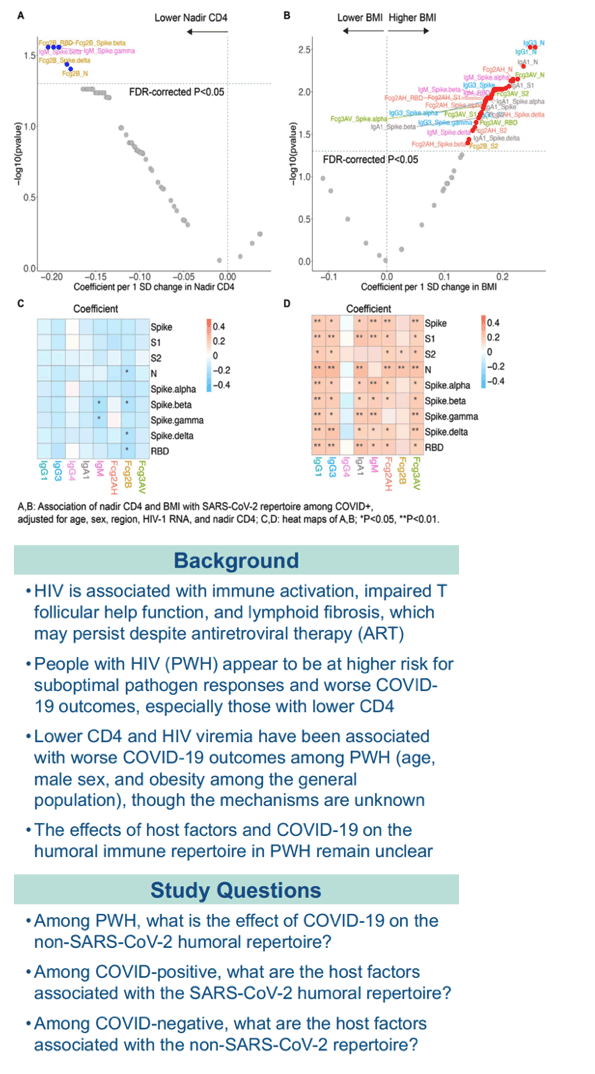
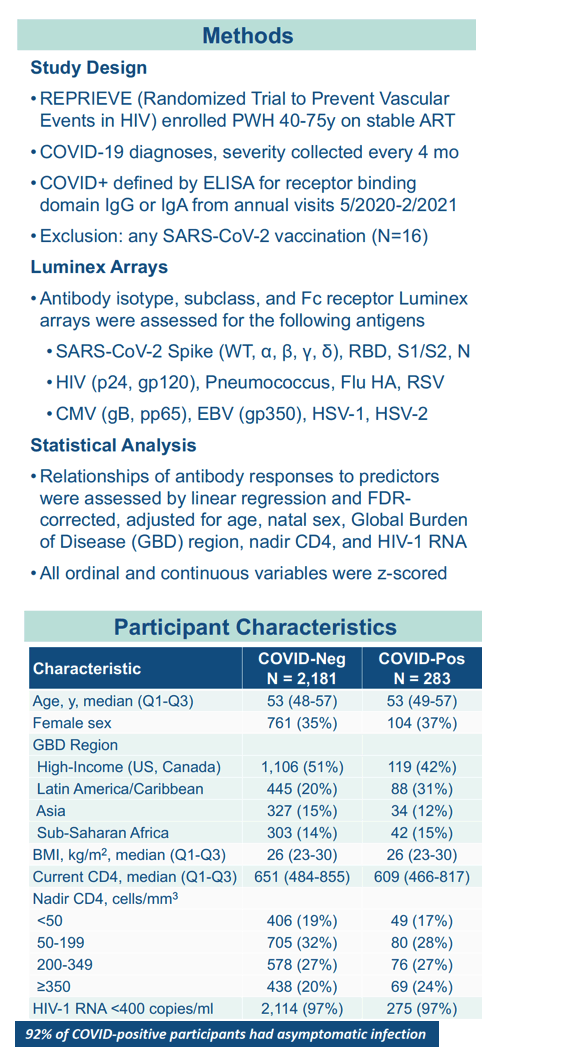
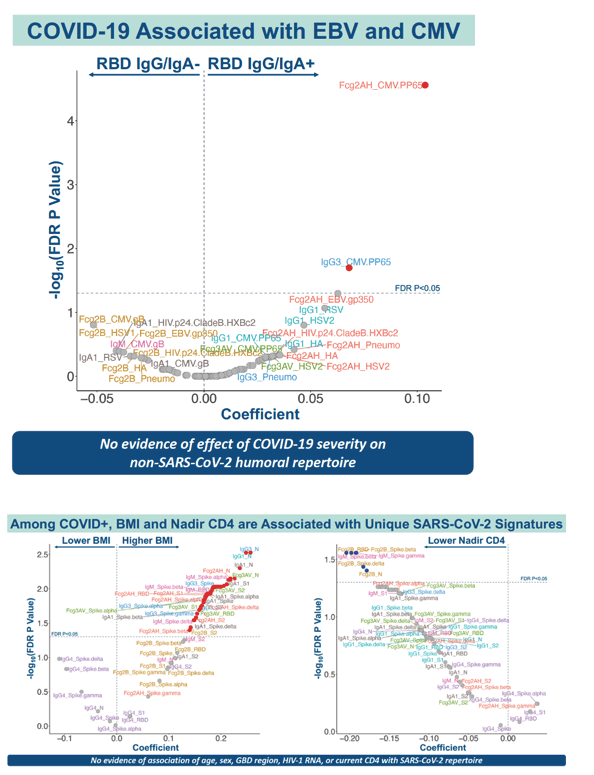
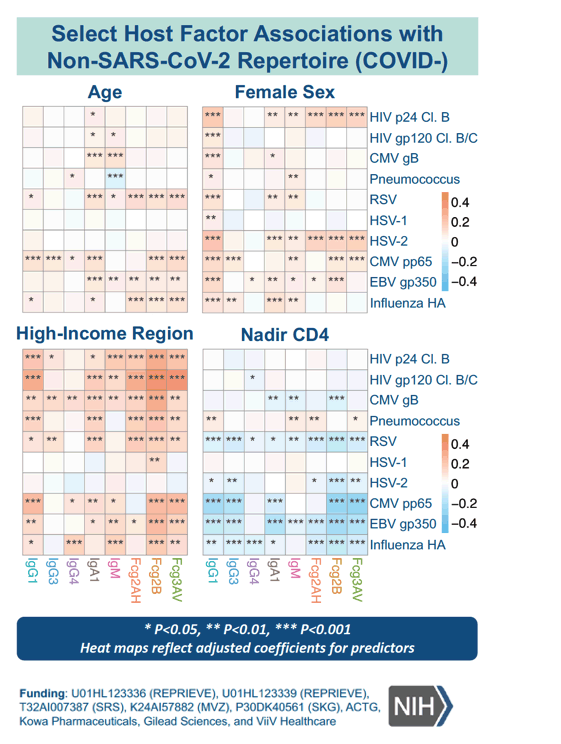
|
| |
|
 |
 |
|
|